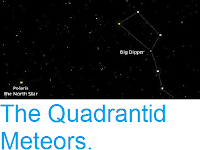On Wednesday 4 January 2017 at 2.17 am, GMT, the Earth will reach its perihelion;
the closest point on its orbit to the Sun, when it will be 147 100 998 km from the Sun. This is because the Earth's orbit is not a perfect circle, but varies by 3.3% over the course of a year. The Earth will reach its furthest point from the Sun, at a distance of 152 092 504 km, at 9.11 pm GMT on 3 July 2016. This perihelion distance varies each year; in 2016 the Earth reached 147 100 176 from the Sun and in 2018 it will reach 147 097 233.
The Earth's Aphelion and Perihelion. My Dark Sky.
This means that the Earth is at its closest to the Sun in the middle of
the Northern Hemisphere's winter, counterintuitive to most of the
planet's population. This is, however, purely coincidental; the Earth's
season's are not caused by its distance from the Sun, which only varies
by 3.3%, but rather by the tilt of the planet. The Earth is currently
tilted at an angle of 25.5° to its plane of orbit (this varies on a
timescale of tens of thousands of years, but remains fixed from the
point of view of any human observer), causing the Sun to appear to rise
higher and lower in the skies of each hemisphere as the year goes by. In
the northern winter the Southern Hemisphere is tilted towards the Sun,
so that the days are longer there (and in around the Southern Solstice
in December, permanently above the horizon at the South Pole). In
addition the Sun being directly overhead means that the energy from the
Sun has to pass through less of the atmosphere before it reaches the
surface of the Earth, so that less energy is lost to the atmosphere,
causing the surface to warm.
How the tilt of the Earth relative to its plane of orbit causes the seasons. ESA.
See also...








